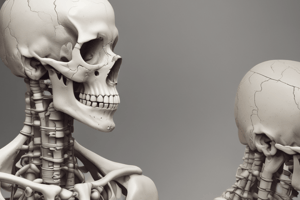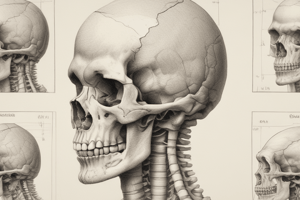Podcast
Questions and Answers
The radiographic diagnosis of bone tumors involves analyzing the lesion in an organized fashion, paying attention to specific radiographic features such as tumor location, margins, and zone of transition.
The radiographic diagnosis of bone tumors involves analyzing the lesion in an organized fashion, paying attention to specific radiographic features such as tumor location, margins, and zone of transition.
True (A)
Patient age is not considered as an important clinical factor in the diagnosis of bone tumors.
Patient age is not considered as an important clinical factor in the diagnosis of bone tumors.
False (B)
The presence of a soft-tissue component is not a consideration in the radiographic diagnosis of bone tumors.
The presence of a soft-tissue component is not a consideration in the radiographic diagnosis of bone tumors.
False (B)
The analysis of bone tumors includes attention to periosteal reaction and mineralization.
The analysis of bone tumors includes attention to periosteal reaction and mineralization.
Lesions have no predilections for specific age groups in the diagnosis of bone tumors.
Lesions have no predilections for specific age groups in the diagnosis of bone tumors.
The approach to the radiographic diagnosis of bone tumors does not involve attention to size and number of lesions.
The approach to the radiographic diagnosis of bone tumors does not involve attention to size and number of lesions.
The term bone tumor encompasses only benign neoplasms and malignant abnormalities.
The term bone tumor encompasses only benign neoplasms and malignant abnormalities.
This article will discuss specific tumors in depth.
This article will discuss specific tumors in depth.
The tables in this article aim to provide lists for memorization of bone lesions.
The tables in this article aim to provide lists for memorization of bone lesions.
Age should be considered precise when categorizing bone tumors according to their classic appearances.
Age should be considered precise when categorizing bone tumors according to their classic appearances.
Tumors do not have a typical patient age range and typical location in the skeleton.
Tumors do not have a typical patient age range and typical location in the skeleton.
The pattern of mineralization of the tumor matrix is often the clue to the type of tumor.
The pattern of mineralization of the tumor matrix is often the clue to the type of tumor.
A well-defined lesion with a sclerotic rim and thick unilamellar periosteal reaction is indicative of an aggressive appearance.
A well-defined lesion with a sclerotic rim and thick unilamellar periosteal reaction is indicative of an aggressive appearance.
Metastatic disease is most common in the age group ⬎40.
Metastatic disease is most common in the age group ⬎40.
This article will provide lists for memorization of different lesions.
This article will provide lists for memorization of different lesions.
Mineralization of chondral tissue is fluffy and cloudlike.
Mineralization of chondral tissue is fluffy and cloudlike.
The radiographic diagnosis of bone tumors involves analyzing the lesion in an organized fashion, paying attention to specific radiographic features such as tumor location, margins, and zone of transition.
The radiographic diagnosis of bone tumors involves analyzing the lesion in an organized fashion, paying attention to specific radiographic features such as tumor location, margins, and zone of transition.
Mineralization of chondral tissue is fluffy and cloudlike.
Mineralization of chondral tissue is fluffy and cloudlike.
Patient age is also an important clinical factor in the diagnosis of bone tumors.
Patient age is also an important clinical factor in the diagnosis of bone tumors.
Metastatic disease is most common in the age group ⬎40.
Metastatic disease is most common in the age group ⬎40.
The presence of a soft-tissue component is not a consideration in the radiographic diagnosis of bone tumors.
The presence of a soft-tissue component is not a consideration in the radiographic diagnosis of bone tumors.
Age should be considered precise when categorizing bone tumors according to their classic appearances.
Age should be considered precise when categorizing bone tumors according to their classic appearances.
The term bone tumor encompasses only benign neoplasms and malignant abnormalities.
The term bone tumor encompasses only benign neoplasms and malignant abnormalities.
Metastatic disease is most common in the age group ⬎40.
Metastatic disease is most common in the age group ⬎40.
The pattern of mineralization of the tumor matrix is often the clue to the type of tumor.
The pattern of mineralization of the tumor matrix is often the clue to the type of tumor.
Patient age is not considered as an important clinical factor in the diagnosis of bone tumors.
Patient age is not considered as an important clinical factor in the diagnosis of bone tumors.
A well-defined lesion with a sclerotic rim and thick unilamellar periosteal reaction is indicative of an aggressive appearance.
A well-defined lesion with a sclerotic rim and thick unilamellar periosteal reaction is indicative of an aggressive appearance.
The approach to the radiographic diagnosis of bone tumors does not involve attention to size and number of lesions.
The approach to the radiographic diagnosis of bone tumors does not involve attention to size and number of lesions.
The analysis of bone tumors includes attention to periosteal reaction and mineralization.
The analysis of bone tumors includes attention to periosteal reaction and mineralization.
This article will discuss specific tumors in depth.
This article will discuss specific tumors in depth.
This article will provide lists for memorization of different lesions.
This article will provide lists for memorization of different lesions.
Lesions have no predilections for specific age groups in the diagnosis of bone tumors.
Lesions have no predilections for specific age groups in the diagnosis of bone tumors.




